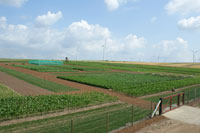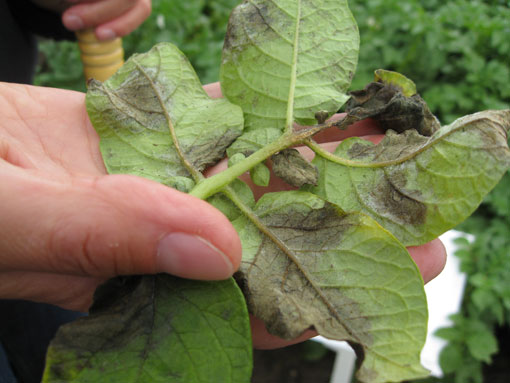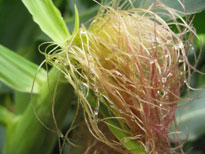Tempting traits waiting in the wings

The latest genetically modified crops being trialled in Europe are open to public at the Uplingen Plant Science Garden in east Germany. James Andrews went along to see what’s in the pipeline.
Potatoes that fend off blight without the aid of pesticides, sugar beet capable of withstanding a dose of glyphosate and maize that wards off its two main pests.
Those are just some of the crops traits awaiting EU approval for them to be grown commercially. But so far, just two GM crops can be grown on farms in the EU. The first, which was granted approval in 1998, is a maize variety with resistance to European corn borer, and the second is a highly efficient starch potato that contains just the right compound for industrial processing.
The Uplingen Science Garden near Berlin has a number of genetically modified plants on show that would offer farmers some significant benefits, should they be approved.
Blight-resistant potato
Top of the wanted list for UK is likely to be blight resistant potatoes. The GM blight resistant potatoes planted in the garden alongside conventional varieties showed a stark contrast. Neither crop had received any blight sprays and while the conventional variety was riddled with the disease, the genetically modified plant was completely blight free.
 |
|---|
|
Late blight in potatoes. |
BASF’s Fortuna potato had been in field trials for four years and the firm hoped to submit a dossier to gain approval for cultivation in the EU in 2011, said Anja Klatt, a plant scientist for the firm. “If everything went to plan it could be approved by as early as 2014, but the EU process is notoriously slow.”
The Amflora industrial starch potato, which was granted cultivation approval earlier this year, took 13 years to pass, so it was unclear how long it would take, she said.
The variety contained a gene from a south American wild potato that was naturally resistant to the late-blight causing phytophtora pathogen. “We have been able to keep the yield potential of the conventional variety, but using biotechnology have inserted the resistance gene.”
Planting phytophtora-resistant potatoes would put an end to numerous blight sprays and would be valuable to organic farmers, said Hans Joerg Jacobsen, head of the institute for plant genetics at Liebniz University, Hannover.
“Copper treatments, really don’t work that well and using them too much kills the soil, so these potatoes would make a viable alternative, even though they may not want to admit it.”
BASF was also working on a second generation Amflora starch potato, said Dr Klatt. “It has better agronomic characteristics and will hopefully give higher yields.”
It was yet to be named and was not designed to be eaten. But, like the Amflora potato was completely safe if consumed by accident, she added.
Glyphosate resistant sugar beet
Roundup ready sugar beet was planted in a number of plots in the science garden. Sugar beet’s relatively slow growth compared with grassweeds meant several herbicide treatments were often required, which could check the crop’s growth, said Pioneer’s Heinz Degenhardt. “Herbicide treatments can make a visible impact on the crop and can reduce yields by up to 8%.”
 |
|---|
|
Roundup Read sugar beet. |
Roundup Ready sugar beet contained a gene derived from a soil bacterium and could be sprayed with small doses of glyphosate to eliminate grassweeds, without harming the beet. The variety was already available in the USA and three years after its launch in 2007 it had taken a 95% market share, he said.
But Roundup Ready sugar beet growers shouldn’t use the product every year as they would increase the chance of glyphosate resistance building up in weed species. “Roundup Ready growers just buy the option to use glyphosate, but they should still use other active ingredients.”
Growers should use their experience and follow guidelines to make sure it is not over used, he said. “Use standard herbicide programmes and save the Roundup for when there are serious problems.”
An application for cultivation in the EU has already been filed, but is not expected before 2015. However, the import of sugar and feed from GM sugarbeet is already approved.
Three-trait EU maize
A maize variety with three genetically modified traits was also on show. It had already approved for import into the EU, but was still awaiting approval for cultivation.
 |
|---|
|
The EU has already given the go-ahead for a new mazie variety with three genetically modified traits |
The variety had the corn borer resistance gene found in MON810, which is already approved for EU cultivation, with the addition of corn root worm-resistance and glyphosate tolerance.
But even three stacked traits were small fry compared with the eight trait varieties available in the USA, said Dr Degenhardt. “This is just the start, you can keep stacking the traits to get more and more benefits.”
Bioplastics and biovaccines
A potato variety containing a natural polymer-producing gene from a bacterium was being tested in the garden.
The cyanophycin gene causes a protein to develop in the tuber. This protein consisted of two natural amino acids which were attached to a biopolymer molecule, said Kerstin Schmidt, executive director of BioTechFarm who operate the Plant Science Garden.
“One component of the molecule is polyaspartate, which can be used as a biodegradable plastic. Polyaspartate bonds calcium and it can therefore be used in detergents as a water softener.”
The second component was an amino acid called Arginin, which could be used as a feed additive and to produce polymers such as nylon, she said.
Another genetically modified potato produced antigens, which could be used as a vaccine against rabbit hemorrhagic disease. “We are analysing how well they will work and how reliable the products will be. We have chosen high-yielding varieties to maximise the amount of product produced and we are also looking at the parts of the plant where most of the substance is produced.
“But I don’t think the potato will be the ultimate plant for producing these products. Sugar beet might be the best crops as it has a much larger volume, but potatoes make a good model to test.”

